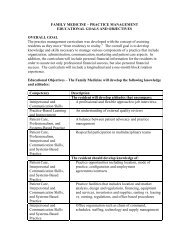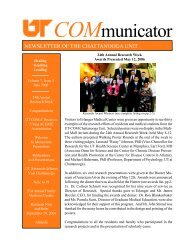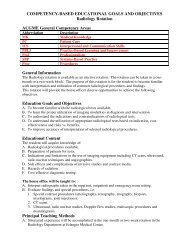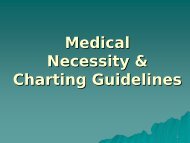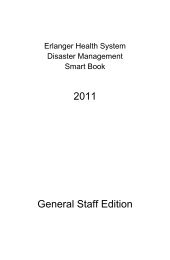Tube Feeding in Patients With Advanced Dementia
Tube Feeding in Patients With Advanced Dementia
Tube Feeding in Patients With Advanced Dementia
Create successful ePaper yourself
Turn your PDF publications into a flip-book with our unique Google optimized e-Paper software.
TUBE FEEDING EFFECTIVENESS IN DEMENTIA<br />
vival was found between groups treated<br />
with and without tube feed<strong>in</strong>g among<br />
1386 patients with recent progression<br />
to severe cognitive impairment. This<br />
f<strong>in</strong>d<strong>in</strong>gpersistedafteradjustmentforage,<br />
prior history of pulmonary aspiration or<br />
stroke, presence of swallow<strong>in</strong>g disorder,<br />
decubitus ulcer, functional state, resuscitation<br />
wishes, and cognitive status. 37<br />
A separate article based on the same data<br />
set described 5266 residents with chew<strong>in</strong>g<br />
and swallow<strong>in</strong>g problems and reported<br />
a significant <strong>in</strong>crease <strong>in</strong> 1-year<br />
mortality among tube-fed patients (risk<br />
ratio, 1.44). 38<br />
Wefoundnopublishedstudiessuggest<strong>in</strong>gthattubefeed<strong>in</strong>gcanprolongsurvival<br />
<strong>in</strong> demented patients with dysphagia.<br />
ARE PRESSURE ULCERS<br />
PREVENTED OR IMPROVED<br />
BY TUBE FEEDING<br />
Data l<strong>in</strong>k<strong>in</strong>g poor nutrient <strong>in</strong>take or abnormal<br />
markers of nutritional status to<br />
pressure ulcers are extremely limited.<br />
In a 1995 review 39 that excluded orthopedic<br />
and sp<strong>in</strong>al cord <strong>in</strong>jury patients,<br />
13 studies found very weak associations<br />
between nutritional status<br />
and pressure sores. Data relat<strong>in</strong>g nutrient<br />
<strong>in</strong>take to pressure sores were<br />
similarly <strong>in</strong>conclusive. No prospective<br />
trials of tube feed<strong>in</strong>g were found,<br />
and retrospective studies found only an<br />
<strong>in</strong>creased risk or no benefit associated<br />
with tube feed<strong>in</strong>g. 39 A MEDLINE search<br />
of enteral nutrition and decubitus ulcer<br />
from 1966 through March 1999 found<br />
no controlled cl<strong>in</strong>ical trials of tube feed<strong>in</strong>g<br />
<strong>in</strong> those with or at risk for pressure<br />
ulcers. Two studies that used an<br />
adm<strong>in</strong>istrative database of more than<br />
800 patients dur<strong>in</strong>g 6 months of follow-up<br />
reported that tube feed<strong>in</strong>g was<br />
not associated with heal<strong>in</strong>g of preexist<strong>in</strong>g<br />
pressure sores, 40 nor with protection<br />
from new pressure sores. 41<br />
Bedfast, <strong>in</strong>cont<strong>in</strong>ent patients with dementia<br />
who are tube fed are more likely<br />
to be restra<strong>in</strong>ed 42 and will probably<br />
make more ur<strong>in</strong>e and stool. Pressure<br />
sore outcomes could be worsened. We<br />
found no published studies suggest<strong>in</strong>g<br />
that tube feed<strong>in</strong>g can improve pressure<br />
sore outcomes.<br />
IS THE RISK OF OTHER<br />
INFECTIONS REDUCED<br />
BY TUBE FEEDING<br />
Aspiration pneumonia and pressure ulcers,<br />
conditions that are sometimes <strong>in</strong>fectious,<br />
have already been considered.<br />
We searched MEDLINE from 1966<br />
through March 1999 us<strong>in</strong>g the terms enteral<br />
nutrition and <strong>in</strong>fection and limited<br />
our search to studies <strong>in</strong>volv<strong>in</strong>g humans.<br />
We found no studies of tube feed<strong>in</strong>g to<br />
reduce the risk of other <strong>in</strong>fections—eg,<br />
ur<strong>in</strong>arytract,viral,gastro<strong>in</strong>test<strong>in</strong>al,oreye<br />
<strong>in</strong>fections. In contrast, feed<strong>in</strong>g tubes can<br />
cause <strong>in</strong>fection. Nasogastric tubes predispose<br />
to <strong>in</strong>fections of the s<strong>in</strong>uses and<br />
middleear.Gastrostomytubeshavebeen<br />
associated with diarrhea (<strong>in</strong>fectious and<br />
non<strong>in</strong>fectious), cellulitis and abscess (at<br />
a rate of 3% to 8%), and rarely with necrotiz<strong>in</strong>g<br />
fasciitis and myositis. 43 Enteral<br />
feed<strong>in</strong>g solutions can be contam<strong>in</strong>ated<br />
with bacteria, perhaps lead<strong>in</strong>g to gastro<strong>in</strong>test<strong>in</strong>al<br />
symptoms. 44 Case reports have<br />
described streptococcal bacteremia follow<strong>in</strong>g<strong>in</strong>sertionofaPEGtube<br />
45 andcontam<strong>in</strong>atedenteralsolutioncaus<strong>in</strong>gnosocomial<br />
bacteremia. 44,46,47 We found no<br />
published studies suggest<strong>in</strong>g that tube<br />
feed<strong>in</strong>g can reduce the risk of <strong>in</strong>fection<br />
<strong>in</strong> dysphagic patients with dementia.<br />
CAN TUBE FEEDING IMPROVE<br />
FUNCTIONAL STATUS<br />
Provid<strong>in</strong>g an emaciated patient with artificial<br />
feed<strong>in</strong>g is sometimes <strong>in</strong>tended<br />
to improve strength, function, or selfcare.<br />
We reviewed a MEDLINE search<br />
of the terms function, functional status,<br />
recovery of function, strength,oractivi-<br />
Table 1. Mortality After <strong>Feed<strong>in</strong>g</strong> <strong>Tube</strong> Placement: Observational Studies*<br />
Study, y Intervention Type of Patient, No. Outcome<br />
Heimbach, 28 1970 Surgical feed<strong>in</strong>g tube Neurogenic, 100 63% Mortality by 1 mo<br />
Mat<strong>in</strong>o, 29 1981 Jejunostomy tube Neurogenic, 54 33% Mortality by 1 mo, 50% mortality<br />
among survivors by 6 mo<br />
Golden et al, 30 1997 PEG tube Mixed population, 102 24% Mortality by 6 mo, 55% mortality by 2 y<br />
Kaw and Sekas, 31 1994 PEG tube Mixed population, 46 20% Mortality by 1 mo, 59% mortality by 18 mo<br />
Hull et al, 19 1993 PEG tube Mixed population, 49 8% Mortality by 1 mo, mean survival 6 mo<br />
Kohli and Block, 20 1995 PEG tube (review of 4 studies) Mixed population, 612 16%-30% Mortality by 1 mo<br />
Nev<strong>in</strong>s, 21 1989 PEG tube or gastrostomy tube Neurogenic, 22 41% Mortality by 3 wks<br />
Fay et al, 32 1991 PEG vs nasoenteric tube Mixed population, 109 50% Mortality by 4 mo for both populations<br />
Hassett et al, 22 1988 Gastrostomy tube Neurogenic, 87 20% Mortality by 1 mo, 40% mortality by 1 y<br />
Grant et al, 23 1998 PEG tube or gastrostomy tube Mixed population, 81 105 24% Mortality by 1 mo, 63% mortality by 1 y,<br />
81.3% mortality by 3 y<br />
F<strong>in</strong>occhiaro et al, 24 1997 PEG tube Mixed population, 136 9.5% Mortality by 1 mo, 58% mortality by 1 y,<br />
65% mortality by 2 y<br />
Loser et al, 33 1998 PEG tube Mixed population, 210 66% Mortality by 1 y<br />
Fisman et al, 34 1999 PEG tube Mixed population, 175 18% Mortality by 30 d, 61% mortality by 1 y<br />
Light et al, 35 1995 PEG tube Mixed population, 416 9% Mortality by 1 mo<br />
Bergstrom et al, 36 1995 Gastrostomy tube Mixed population, 77 21% Mortality by 1 mo, 64% mortality by 1 y<br />
*Neurogenic <strong>in</strong>dicates dementia, cerebrovascular accident, trauma, anoxic bra<strong>in</strong> <strong>in</strong>jury, Park<strong>in</strong>son disease, Guilla<strong>in</strong>-Barré syndrome, or motor neuron disease; PEG, percutaneous<br />
endoscopic gastrostomy; and mixed population, patients with neurogenic mechanical disorders and cancer.<br />
©1999 American Medical Association. All rights reserved. JAMA, October 13, 1999—Vol 282, No. 14 1367<br />
Downloaded from www.jama.com at MEDICAL LIB on December 15, 2008






